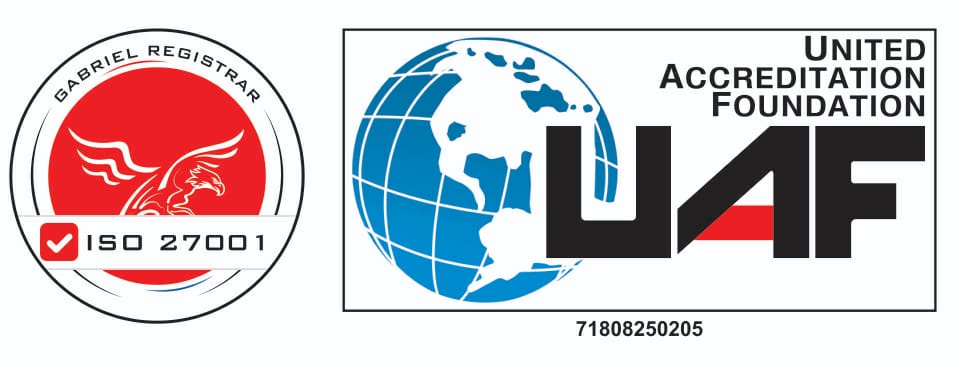APIs (Application Programming Interfaces) have become a crucial part of software development, enabling seamless communication between different applications and services.
As APIs continue to proliferate, ensuring their security has become a top priority. Two fundamental concepts in API security are authentication and authorization.
In this article, we will explore the concepts of What is Authorization and Authentication in API Testing? their significance, and how to test them effectively.
Authentication in API Testing
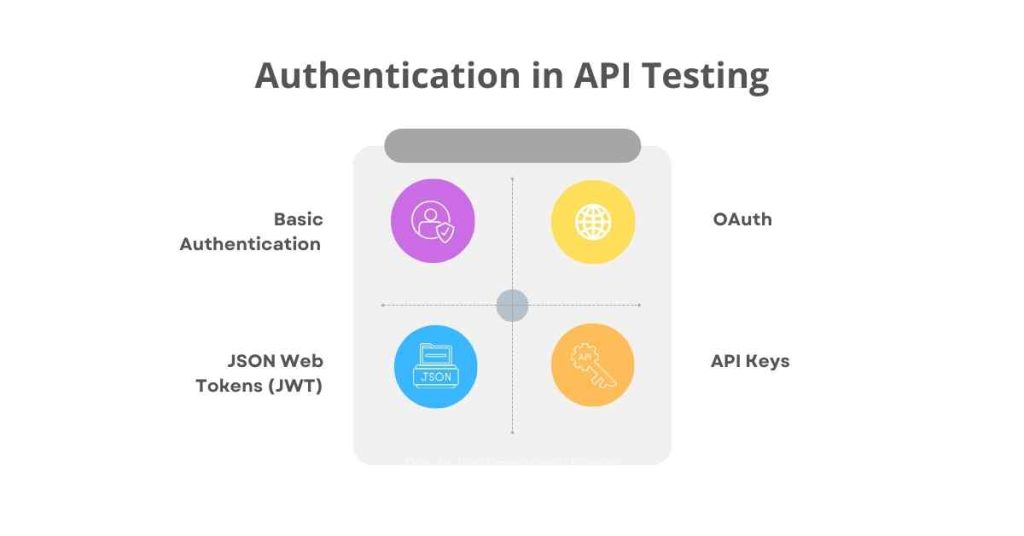
Authentications refer to measures used to positively identify a user, device or system that seeks to transact with an API.
This refers to the confirmation of the qualifications claimed by the entity, such as a username and password. The general purpose of authentication is to protect an API and all of the resources associated with it from unauthorized access.
There are several authentication methods used in APIs, including:
1. Basic Authentication
This is the simplest form of authentication where for each request a username and password are passed. Credentials are normally encoded using Base64 and the parameter is placed in the Authorization header.
2. OAuth
This is a traditional authorization framework wherein an application gets limited access to a user’s resource on another service provider’s website. OAuth is popular nowadays in the formation of many APIs because it allows to safely and efficiently grant access to necessary resources.
3. JSON Web Tokens (JWT)
JWT is an authentication mechanism of token type, where the user credentials are encapsulated as a JSON object. The token, in fact, is also encrypted and checked by the server to prove the token’s actuality.
4. API Keys
Some APIs utilize API keys which are string identifiers provided to a user or an application. API keys are most often passed in the header or in the query string of the HTTP request.
Authorization in API Testing
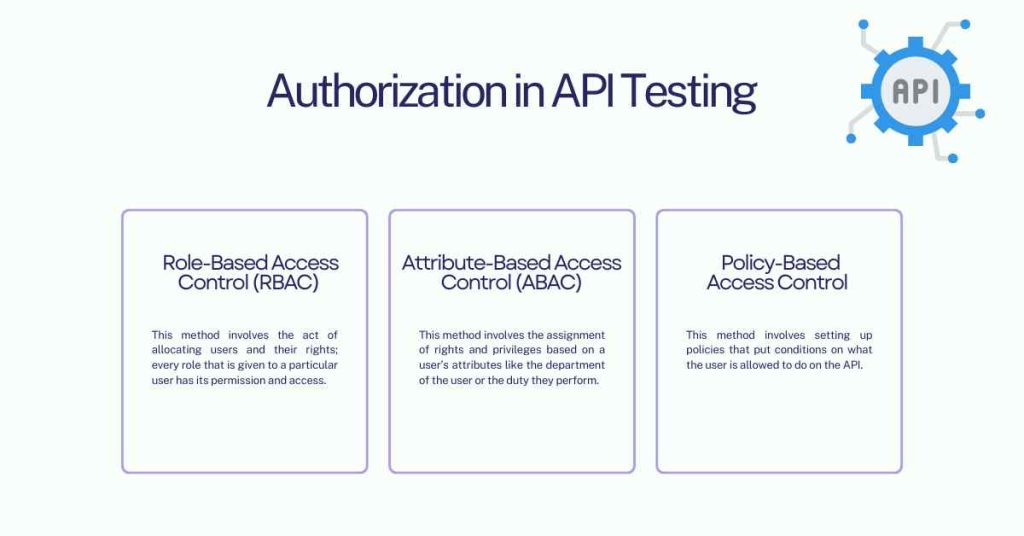
Authorization in any API defines the operations a logged-in user is permitted to execute. It may include user authentication and authorization of the ensuing availability and permission level on certain fixed resources or targets.
Authorization serves to make sure that a user who has been authenticated only gets to access specific resources as well as data to which he or she is allowed to.
There are several authorization methods used in APIs, including:
1. Role-Based Access Control (RBAC)
This method involves the act of allocating users and their rights; every role that is given to a particular user has its permission and access.
2. Attribute-Based Access Control (ABAC)
This method involves the assignment of rights and privileges based on a user’s attributes like the department of the user or the duty they perform.
3. Policy-Based Access Control
This method involves setting up policies that put conditions on what the user is allowed to do on the API.
Testing Authentication and Authorization in APIs
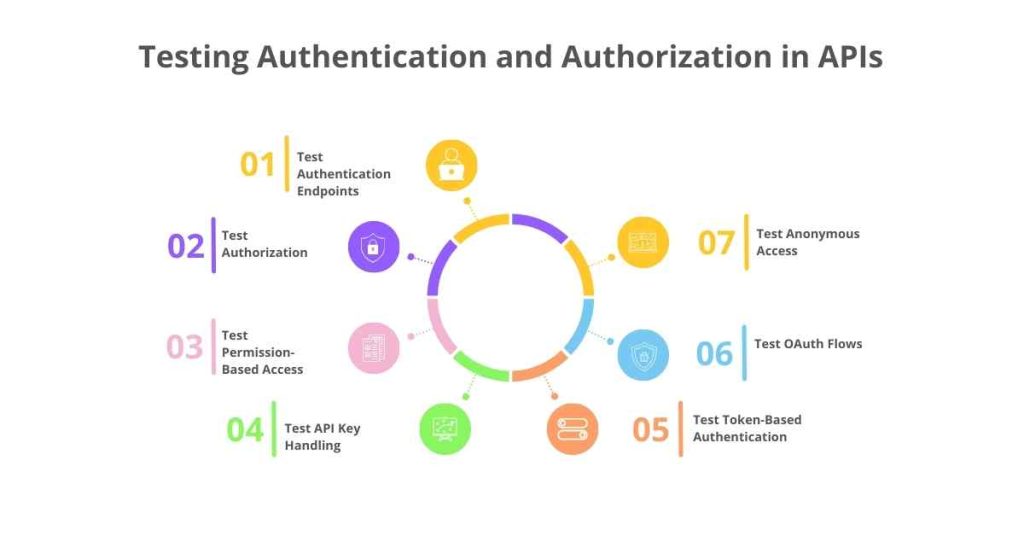
Testing authentication and authorization in APIs is crucial to ensure that only authorized users have access to sensitive resources and data. Here are some tips for testing authentication and authorization in APIs:
1. Test Authentication Endpoints
For several clicks, make sure that the authentication endpoints to check whether the CPU is properly validating the user’s credentials and appropriately issuing the token or session.
2. Test Authorization
Test the authorization process rigorously to check what exactly the user is authorized to and not to access in terms of resources and endpoints.
3. Test Permission-Based Access
You have to test the permission-based access to understand those granted access to the resources and endpoints in the new operating system.
4. Test API Key Handling
Sometimes it is necessary to use a dummy API key just to check how this information is validated and whether unauthorized people will be able to gain access to such data.
5. Test Token-Based Authentication
Perform various types of token-based authentication in order to learn whether processes of token generation, token validation, and token refreshing are executed successfully.
6. Test OAuth Flows
Use the OAuth test to check that the right permissions have been requested as well as verify access tokens are being appropriately generated.
7. Test Anonymous Access
You should test anonymous access to check whether any unauthorized person can access any of the important resources and information or not.
Top 5 Best Practices for Testing Authentication and Authorization
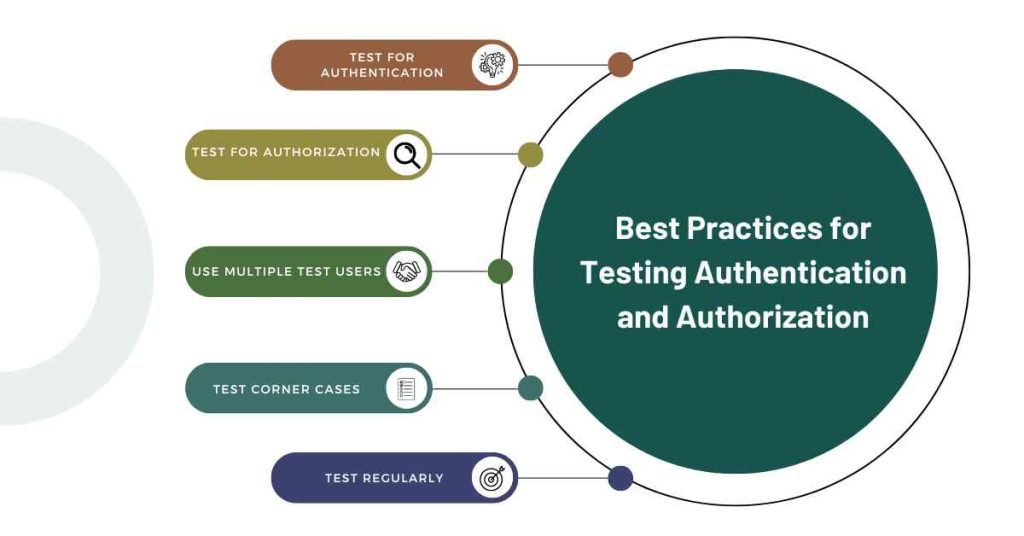
Here are some best practices for testing authentication and authorization in APIs:
1. Test for Authentication
Check for authentication, to limit users, who have access to specific resources and information, which is important for their business.
2. Test for Authorization
To check for authorization users are permitted to only access and interact with resources and endpoints they are allowed.
3. Use Multiple Test Users
Added to that, you should utilize numerous test users with different authorities and privileges to check the authorization process.
4. Test Corner Cases
Use edge cases, erroneous possibilities, and peculiarities of the end-user to validate how the authentication and authorization are performed.
5. Test Regularly
Perform tests on authentication and authorization frequently so as not to allow changes and updates to bring in vulnerabilities.
Conclusion
In conclusion, authentication and authorization are crucial aspects of API security. Testing these processes is essential to ensure that only authorized users have access to sensitive resources and data.
By using the right tools and techniques, and following best practices, developers and testers can ensure that their APIs are secure and properly authenticated and authorized.
FAQs: What is Authorization and Authentication in API Testing?
1. What is the difference between authentication and authorization?
Ans: Authentication is the process of verifying the identity of a user, device, or system, while authorization is the process of determining what actions an authenticated user can perform on an API.
2. Why is testing authentication and authorization important in APIs?
Ans: Testing authentication and authorization is important to ensure that only authorized users have access to sensitive resources and data, preventing unauthorized access and potential security breaches.
3. What are the different types of authentication methods used in APIs?
Ans: There are several authentication methods used in APIs, including Basic Authentication, OAuth, JSON Web Tokens (JWT), and API Keys.
4. What is OAuth and how is it used in APIs?
Ans: OAuth is an industry-standard authorization framework that enables applications to obtain limited access to a user’s resources on another service provider’s website. It is widely used in modern APIs to provide a secure and standardized way of authorizing access to resources.
5. What is the role of JSON Web Tokens (JWT) in API authentication?
Ans: JSON Web Tokens (JWT) are a token-based authentication method that uses a JSON object to encode the user’s credentials. The token is digitally signed and verified by the server to ensure its authenticity.
6. How can I test authentication and authorization in APIs?
Ans: You can test authentication and authorization in APIs using tools such as Postman, SoapUI, and mocking. Additionally, testing multiple test users with different roles and permissions can help ensure that the authorization process is correctly implemented.
7. What are the best practices for testing authentication and authorization in APIs?
Ans: Best practices for testing authentication and authorization include testing for authentication and authorization, using multiple test users, testing corner cases, and testing regularly to ensure that changes and updates do not introduce vulnerabilities.
8. How often should I test authentication and authorization in APIs?
Ans: Authentication and authorization should be tested regularly, ideally as part of a continuous integration and continuous deployment (CI/CD) pipeline, to ensure that changes and updates do not introduce vulnerabilities.
9. What are the consequences of not testing authentication and authorization in APIs?
Ans: Not testing authentication and authorization in APIs can lead to security breaches, unauthorized access to sensitive resources and data, and reputational damage.
10. What are some common tools used for testing authentication and authorization in APIs?
Ans: Some common tools used for testing authentication and authorization in APIs include Postman, SoapUI, Burp Suite, and SSL Labs.








